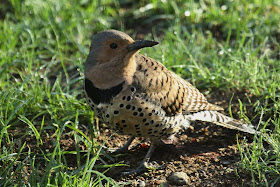 |
| Rock Pigeon nesting in Elliott St retaining wall - a non-native bird that adapts to urban habitat |
On Main Street, nondescript brown birds pick crumbs dropped by diners from beneath sidewalk tables. House Sparrows are the second species that has adapted and manages to make its living in the barren habitat of downtown streets.
 |
| Northern Flicker - a species favored by milliners for adorning feathered hats |
But there was a time when a skilled observer could identify many such birds in the barren urban habitats of our cities. Frank M. Chapman was such an observer. He was an ornithologist and curator of the bird collections at the American Museum of Natural History in New York City. He developed the innovative exhibits which displayed birds in their natural habitats.
 |
| Feather adorned hat on display at John James Audubon Center at Millgrove, Pennsylvania |
The feather trade was thriving, and birds were dying to provide high fashion ladies with elaborate evidence of their taste and prosperity. Women’s hats became larger and ornamentation more lavish. The feather trade exploded. 64 species of native birds were hunted, and exploited, for their feathers.
 |
| Great Egret - demand for the breeding plumes nearly led its extinction |
Herbert Job, an ornithologist and pioneer wildlife photographer, wrote about the feather trade: “Here are some official figures of the trade from one source alone, of auctions at the London Commercial Sales Rooms during 1902. There were sold 1,608 packages of ... herons’ plumes. A package is said to average in weight 30 ounces. This makes a total of 48,240 ounces. As it requires about four birds to make an ounce of plumes, these sales meant 192,960 herons killed at their nests, and from two to three times that number of young or eggs destroyed. Is it, then, any wonder that these species are on the verge of extinction?”
In 1903, feathers sold for $32 per ounce, twice the price for an ounce of gold. The millinery trade employed 83,000 people (1 of every 1000 Americans) in 1900.
 |
| Herons, such at the Great Blue, were sought after by the millinery industry |
Gradually the “Age of Extermination” came to an end. Dwindling supplies caused prices to soar. Fashion evolved new directions. Women’s life styles changed. And governments acted. In 1916 the United States and Great Britain (on behalf of Canada) signed the Migratory Bird Treaty and in 1918 Congress enacted the treaty into law. The Act established Federal responsibilities for the protection of nearly all species of birds, their eggs and nests.
The Migratory Bird Treaty Act (MBTA) made it illegal for people to "take" migratory birds, their eggs, feathers or nests. “Take is defined in the MBTA to include by any means or in any manner, any attempt at hunting, pursuing, wounding, killing, possessing or transporting any migratory bird, nest, egg, or part thereof ... In total, 836 bird species are protected by the MBTA, 58 of which are currently legally hunted as game birds. A migratory bird is any species or family of birds that live, reproduce or migrate within or across international borders at some point during their annual life cycle.” (www.fws.gov)
 |
| Blue Jay feathers are silent evidence of a hawk kill |
He had seen photographs I had posted of the feather remains of a Blue Jay which had been taken by a hawk in my backyard. I replied that I photograph the feathers, sometimes study or examine them, but do not keep them. I could not send feathers to Holland because I do not have any and because it is illegal under the MBTA to possess or transport feathers.
Feather collecting, and the companion hobby, egg collecting (known as oology) are illegal in the United States, Canada, United Kingdom and many other jurisdictions. Underground and illegal collecting continues.
The MBTA allows special permits for protected nongame species that become local pests (e.g., giant flocks of winter roosting blackbirds). No other birds, except those for which there are designated hunting seasons, can be legally killed, trapped, harassed, or possessed (including birds found dead). Even “adoption” of young birds that appear to have been deserted by their parents is illegal without a permit.
 |
| Feather adorned hat on display at John James Audubon Center at Millgrove, Pennsylvania |
Even more fortunately, we can see the flickers, waxwings, and dozens of other species in our backyards, fields, orchards, ponds, and forests. They are protected. Watch them and enjoy them.
Good Birding!

Thanks for sharing it dear, like it.. and i want to tell you that i am study about Psychology, and finding some relevant answers.
ReplyDeletePsychology